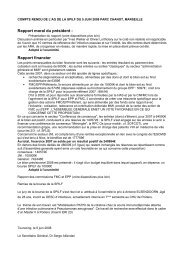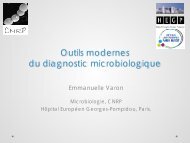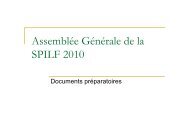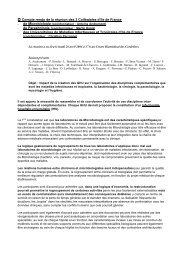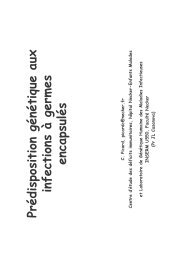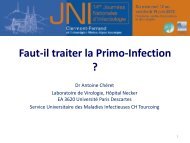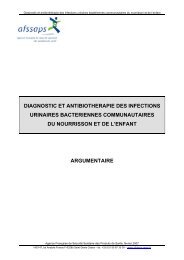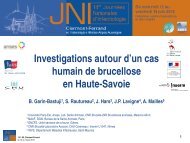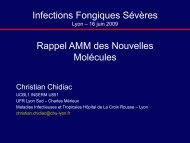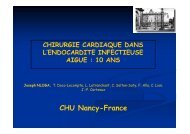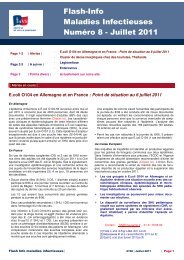Management of lower respiratory tract infections - Infectiologie
Management of lower respiratory tract infections - Infectiologie
Management of lower respiratory tract infections - Infectiologie
Create successful ePaper yourself
Turn your PDF publications into a flip-book with our unique Google optimized e-Paper software.
15TH CONSENSUS CONFERENCE ON ANTI-INFECTIVE THERAPY<br />
MANAGEMENT OF LOWER RESPIRATORY<br />
TRACT INFECTIONS IN<br />
IMMUNOCOMPETENT ADULTS<br />
WEDNESDAY 15 MARCH 2006<br />
Institut Pasteur - Centre d’Information Scientifique - 28 rue du Docteur Roux - 75015 Paris<br />
organized by the Société de Pathologie Infectieuse de Langue Française<br />
with the participation <strong>of</strong> the following scientific societies:<br />
• APNET (Association Pédagogique Nationale pour l’Enseignement de la Thérapeutique)<br />
• APP (Association de Perfectionnement des Pneumologues Libéraux)<br />
• CMIT (Collège des Universitaires de Maladies Infectieuses et Tropicales)<br />
• SFM (Société Française de Microbiologie)<br />
• SFMU (Société Francophone de Médecine d’Urgence)<br />
• SNFMI (Société Nationale Française de Médecine Interne)<br />
• SPLF (Société de Pneumologie de Langue Française)<br />
• SRLF (Société de Réanimation de Langue Française)<br />
Correspondence<br />
ymouton@hotmail.com and christian.chidiac@chu-lyon.fr<br />
SOCIÉTÉ DE PATHOLOGIE INFECTIEUSE DE LANGUE FRANÇAISE<br />
President: Jean-Paul Stahl<br />
Maladies infectieuses et tropicales. CHU de Grenoble – BP 217, 38043 Grenoble Cedex<br />
Phone: + 33 (0) 476 765 291 - Fax: +33 (0) 476 765 569<br />
CONSENSUS AND GUIDELINES OFFICE OF THE SOCIÉTÉ DE PATHOLOGIE INFECTIEUSE DE LANGUE<br />
FRANÇAISE<br />
Christian Chidiac (coordinator), Jean-Pierre Bru, Patrick Choutet, Jean-Marie Decazes, Luc Dubreuil, Catherine<br />
Leport, Bruno Lina, Christian Perronne, Denis Pouchain, Béatrice Quinet, Pierre Weinbreck<br />
Short text– page 1<br />
This text is protected by copyright owned by SPILF. Reproduction and distribution rights are granted by SPILF on request, provided the text is reproduced in<br />
full, with no addition or deletion, and provided SPILF and the references <strong>of</strong> the original article in Médecine et Maladies Infectieuses are indicated.
ORGANIZATION COMMITTEE<br />
Chairman: Christian Chidiac<br />
Maladies infectieuses et tropicales. Hôpital de la Croix Rousse<br />
CHU de Lyon - 103 grande rue de la Croix Rousse, 69317 Lyon Cedex 04<br />
Phone: +33 (0) 472 071 745 - Fax: +33 (0) 472 071 011 - E-mail: christian.chidiac@chu-lyon.fr<br />
ORGANIZATION COMMITTEE MEMBERS<br />
Henri Dabernat CHU Purpan, Toulouse Microbiology<br />
Thanh Doco-Lecompte CHU Brabois, Nancy Infectious and Tropical Diseases<br />
Xavier Duval Hôpital Bichat-Claude Bernard, Paris Therapeutics<br />
David Elkharrat Hôpital Ambroise-Paré, Boulogne Emergency Room<br />
Paul Léophonte CHU Rangueil,Toulouse Respiratory Medicine<br />
Bruno Lina Hôpital Edouard Herriot, Lyon Virology<br />
Yves Rogeaux Maison médicale, Villeneuve d'Ascq Respiratory Medicine<br />
Marie Thuong Guyot Hôpital Delafontaine, Saint-Denis Medical Intensive Care<br />
Pierre Veyssier CH de Compiègne Internal Medicine<br />
JURY<br />
Chairman: Yves Mouton<br />
Maladies infectieuses et tropicales. CH Gustave Dron - 135 rue du Président Coty, 59208 Tourcoing Cedex<br />
Phone: +33 (0)320 694 616 - Fax: +33 (0) 320 694 615<br />
MEMBERS OF THE JURY<br />
Jacques Birgé Boulay-sur-Moselle General practitioner<br />
Jean-Pierre Bru CH d’Annecy Infectious and Tropical Diseases<br />
LoIk Geffray Centre hospitalier de Lisieux Internal Medicine<br />
Patrice Massip CHU Purpan, Toulouse Infectious and Tropical Diseases<br />
Bruno Megarbane Hôpital Lariboisière, Paris Medical Intensive Care<br />
Jean-François Muir CHU de Bois-Guillaume, Rouen Respiratory Medicine<br />
Yves Péan Institut Mutualiste Montsouris, Paris Microbiology<br />
Christian Perronne Hôpital Raymond Poincaré, Garches Infectious and Tropical Diseases<br />
Roland Poirier CH du Pays d’Aix, Aix-en-Provence Respiratory Medicine<br />
Alain Potier Artannes sur Indre General practitioner<br />
Eric Roupie CHU Côte de Nacre, Caen Emergency Room<br />
Claude-James Soussy CHU Henri Mondor, Créteil Microbiology<br />
Christophe Trivalle Hôpital Paul Brousse, Villejuif Gerontology<br />
Short text– page 2<br />
This text is protected by copyright owned by SPILF. Reproduction and distribution rights are granted by SPILF on request, provided the text is reproduced in<br />
full, with no addition or deletion, and provided SPILF and the references <strong>of</strong> the original article in Médecine et Maladies Infectieuses are indicated.
EXPERTS<br />
Jean-Pierre Bédos Hôpital André Mignot, Le Chesnay Intensive Care<br />
Pascal Chavanet Hôpital du Bocage, Dijon Infectious and Tropical Diseases<br />
Christian Chidiac Hôpital de la Croix Rousse, Lyon Infectious and Tropical Diseases<br />
Bruno Fantin Hôpital Beaujon, Clichy Internal Medicine<br />
Michel Garré CHU de la Cavale Blanche, Brest Internal Medicine and Infectious<br />
Diseases<br />
Bruno Housset CHI, Créteil Respiratory Medicine<br />
Gérard Huchon Hôpital de l'Hôtel Dieu, Paris Respiratory Medicine<br />
Olivier Leroy CH Gustave-Dron, Tourcoing Medical Intensive Care and<br />
Infectious Diseases<br />
Charles Mayaud Hôpital Tenon, Paris Respiratory Medicine<br />
Gilles Potel Hôtel Dieu, Nantes Emergency Room<br />
Jordi Roig Hospital Nostra Senyora de Meritxell, Respiratory Medicine<br />
Principauté d’Andorre<br />
Bernard Rouveix Hôpital Cochin, Paris Clinical Pharmacology<br />
Benoit Schlemmer Hôpital Saint-Louis, Paris Medical Intensive Care<br />
François Trémolières Villennes-sur-Seine Internal Medicine<br />
Emmanuelle Varon HEGP, Paris Microbiology<br />
MEMBERS OF THE LITERATURE REVIEW GROUP<br />
Pierre-Régis Burgel Hôpital Cochin, Paris, Respiratory Medicine<br />
Éric Denes CHU Dupuytren, Limoges Infectious and Tropical Diseases<br />
Karine Faure CH Gustave-Dron, Tourcoing Medical Intensive Care and<br />
Infectious Diseases<br />
François Philippart Fondation-Hôpital Saint-Joseph, Paris Medical and Surgical Intensive Care<br />
MODERATORS<br />
Christiane Bébéar Université Victor Segalen Bordeaux 2 Microbiology<br />
Jean-Didier Cavallo HIA Bégin, Saint-Mandé Microbiology<br />
Patrick Choutet CHU Bretonneau,Tours Infectious and Tropical Diseases<br />
Paul Léophonte CHU Rangueil,Toulouse Respiratory Medicine<br />
Henri Portier Hôpital du Bocage, Dijon Infectious and Tropical Diseases<br />
François Raffi Hôtel-Dieu, Nantes Infectious and Tropical Diseases<br />
Marie Thuong Guyot Hôpital Delafontaine, Saint-Denis Medical Intensive Care<br />
Pierre Weinbreck CHU Dupuytren, Limoges Infectious and Tropical Diseases<br />
The SPILF would like to thank the following companies for their help in organizing this conference: Abbott, Bayer<br />
Pharma, Boehringer Ingelheim, Bristol Myers-Squibb, Chiron France, GlaxoSmithKline, Merck Sharp & Dohme, Pfizer,<br />
Roche, san<strong>of</strong>i aventis, san<strong>of</strong>i pasteur MSD, Wyeth Pharmaceuticals France.<br />
SECRETARY<br />
VIVACTIS PLUS • 17 rue Jean Daudin • 75015 Paris • Phone: +33 (0)143 376 800 • Fax: +33 (0) 143 376 503 •<br />
contact@vivactisplus.com<br />
Short text– page 3<br />
This text is protected by copyright owned by SPILF. Reproduction and distribution rights are granted by SPILF on request, provided the text is reproduced in<br />
full, with no addition or deletion, and provided SPILF and the references <strong>of</strong> the original article in Médecine et Maladies Infectieuses are indicated.
INTRODUCTION<br />
In 1991, the consensus conference organized in Lille by the Société de Pathologie Infectieuse de Langue Française<br />
(SPILF) on antibiotic therapy for <strong>respiratory</strong> <strong>tract</strong> <strong>infections</strong> was the first conference <strong>of</strong> this type to be organized in<br />
the world. However, in the absence <strong>of</strong> publication in an English language journal, this conference was ignored by<br />
the international medical community in favour <strong>of</strong> the English conference held in 1993. Since then, so many<br />
guidelines on this theme have been proposed that it is difficult to take them all into account, as each country, and in<br />
some countries, each society or institution, has defined its own set <strong>of</strong> guidelines on this subject, sometimes several<br />
times each decade. This phenomenon is certainly correlated with the large place occupied by <strong>respiratory</strong> <strong>tract</strong><br />
<strong>infections</strong> in clinical practice, especially general practice, and therefore in health expenditure.<br />
The SPILF, based on its experience <strong>of</strong> 14 previous consensus conferences, covering a very broad range <strong>of</strong><br />
infectious diseases, invited its partners, Association Pédagogique Nationale pour l’Enseignement de la<br />
Thérapeutique (APNET), Association de Perfectionnement des Pneumologues Libéraux (APP), Collège des<br />
Universitaires des Maladies Infectieuses et Tropicales (CMIT), Société Française de Microbiologie (SFM), Société<br />
Francophone de Médecine d’Urgence (SFMU), Société Nationale Française de Médecine Interne (SNFMI), Société<br />
de Pneumologie de Langue Française (SPLF), and Société de Réanimation de Langue Française (SRLF) to<br />
participate in the organization <strong>of</strong> a consensus conference on the management <strong>of</strong> <strong>lower</strong> <strong>respiratory</strong> <strong>tract</strong><br />
<strong>infections</strong> in immunocompetent adults.<br />
The purpose <strong>of</strong> this conference was not to add yet another set <strong>of</strong> guidelines to the long list <strong>of</strong> available guidelines,<br />
but rather to try to encourage a change <strong>of</strong> attitude and to integrate the concept <strong>of</strong> networking <strong>of</strong> public and private<br />
healthcare structures, to go beyond the limited objective <strong>of</strong> guidelines for the choice <strong>of</strong> anti-infective agents in order<br />
to define an optimized patient management, to integrate the goal <strong>of</strong> individual benefit into that <strong>of</strong> public health<br />
management. Another objective was to start the 21st century by taking into account the progress in diagnostic<br />
methods, particularly the currently available and future modalities <strong>of</strong> imaging, molecular biology, and rapid<br />
diagnostic tests, whenever they can improve the quality <strong>of</strong> care for the patient, and a rational management <strong>of</strong><br />
healthcare for the community: early virological diagnosis, avoiding inappropriate antibacterial therapy in favour <strong>of</strong><br />
specific antiviral therapy represents a benefit for both the individual and the community. Vaccination extended to<br />
groups that are either responsible for diffusion <strong>of</strong> <strong>respiratory</strong> <strong>tract</strong> infectious agents, or suffering from severe forms<br />
<strong>of</strong> infection by these agents is also beneficial for the individual and the community. In the more conventional, but<br />
still topical, field <strong>of</strong> bacteria and antibacterials, we needed to revise bacterial epidemiology and the growth <strong>of</strong><br />
resistance, by noting the stability <strong>of</strong> certain data, allowing a certain respite for prescribers <strong>of</strong> molecules known and<br />
monitored for a long time, but also predicting the ecological impact <strong>of</strong> a possible overuse <strong>of</strong> a given group <strong>of</strong><br />
molecules.<br />
Short text– page 4<br />
This text is protected by copyright owned by SPILF. Reproduction and distribution rights are granted by SPILF on request, provided the text is reproduced in<br />
full, with no addition or deletion, and provided SPILF and the references <strong>of</strong> the original article in Médecine et Maladies Infectieuses are indicated.
QUESTION 1<br />
HOW TO DIAGNOSE LOWER RESPIRATORY TRACT INFECTION?<br />
WHAT CLINICAL AND COMPLEMENTARY DIAGNOSTIC METHODS CAN BE USED TO DISTINGUISH<br />
BRONCHIAL INFECTION FROM LUNG INFECTION?<br />
The term “<strong>lower</strong> <strong>respiratory</strong> <strong>tract</strong> infection” (LRTI) refers to three distinct clinical entities: acute bronchitis with a<br />
benign course, pneumonia, responsible for a mortality <strong>of</strong> up to 15%, and acute exacerbation <strong>of</strong> chronic obstructive<br />
pulmonary disease with a variable prognosis; general practitioners ensure the management <strong>of</strong> 96% to 98% <strong>of</strong><br />
cases <strong>of</strong> these <strong>infections</strong>.<br />
ACUTE BRONCHITIS<br />
Acute bronchitis is a very frequent infection (10 million cases per year in France), usually due to a virus, occurring<br />
in an epidemic setting. The diagnosis is clinical: no complementary investigation is useful and chest x-ray is<br />
reserved to cases with a doubtful diagnosis. Uncomplicated acute bronchitis usually resolves over about ten days.<br />
Complications are rare. No clinical trial has demonstrated the value <strong>of</strong> antibiotics. Antibiotics are not indicated for<br />
acute bronchitis in healthy adults since 1991: (SPILF 1991, AFSSAPS 2005) (Grade A recommendation).<br />
ACUTE PNEUMONIA<br />
Acute pneumonia is an infection <strong>of</strong> the lung parenchyma with an estimated frequency <strong>of</strong> 400,000 to 600,000 cases<br />
per year in France. Only community-acquired pneumonia (CAP) was considered at this consensus conference. The<br />
diagnosis is difficult. It is based on a body <strong>of</strong> clinical and radiological evidence dependent on the examination<br />
technique and the examiner’s experience. Clinical signs include cough, dyspnoea, lateral chest pain, sputum, fever,<br />
tachycardia, tachypnoea, an impression <strong>of</strong> severity, localized dullness, and zones <strong>of</strong> crackles, but they are rarely all<br />
present.<br />
The presence <strong>of</strong> unilateral crackles has a good positive predictive value for CAP (Pr<strong>of</strong>essional consensus), while a<br />
combination <strong>of</strong> <strong>respiratory</strong> rate < 30/min, pulse < 100 bpm and temperature < 37.9°C has a good negative<br />
predictive value for CAP (Grade B recommendation).<br />
The clinical features are even more misleading in the elderly and may sometimes be limited to confusion,<br />
tachypnoea, dyspnoea, or deterioration <strong>of</strong> a pre-existing chronic disease.<br />
The AP chest x-ray, possibly completed by a lateral film, is essential (Pr<strong>of</strong>essional consensus). Systematized<br />
alveolar opacities are easily recognized. In contrast, interstitial opacities and peribronchial clumped opacities<br />
suggestive <strong>of</strong> “bronchopneumonia” are more difficult to identify. The diagnosis is even more difficult in the elderly<br />
due to frequent pre-existing abnormalities, the high prevalence <strong>of</strong> bronchopneumonia forms, and the technical<br />
difficulties <strong>of</strong> radiography.<br />
Unenhanced CT scan is useful in cases presenting diagnostic difficulties. CT angiography is reserved for the<br />
differential diagnosis <strong>of</strong> pulmonary embolism.<br />
The contribution <strong>of</strong> laboratory tests to the diagnosis <strong>of</strong> CAP has been poorly evaluated. Marked leukocytosis and<br />
high CRP and procalcitonin values are in favour <strong>of</strong> bacterial CAP. Inversely, low CRP and procalcitonin values<br />
confirmed on D2 argue against bacterial infection. At the present time, in outpatient medicine, it appears logical to<br />
limit laboratory tests to patients with an uncertain diagnosis.<br />
Short text– page 5<br />
This text is protected by copyright owned by SPILF. Reproduction and distribution rights are granted by SPILF on request, provided the text is reproduced in<br />
full, with no addition or deletion, and provided SPILF and the references <strong>of</strong> the original article in Médecine et Maladies Infectieuses are indicated.
ACUTE EXACERBATIONS OF CHRONIC OBSTRUCTIVE PULMONARY DISEASE<br />
An estimated 2,000,000 cases <strong>of</strong> acute exacerbations <strong>of</strong> chronic obstructive pulmonary disease are observed each<br />
year in France, responsible for 40,000 to 60,000 hospitalisations. They usually occur in a patient with known COPD,<br />
but can sometimes be the first sign <strong>of</strong> COPD. This slowly progressive chronic disease, essentially caused by<br />
smoking, is characterized by partly reversible bronchial obstruction (FEV 1/VC ratio less than 70%). The severity <strong>of</strong><br />
COPD must be evaluated by a pulmonary function tests after resolution <strong>of</strong> the acute episode, allowing classification<br />
in stages <strong>of</strong> severity, facilitating optimal patient management.<br />
The diagnosis <strong>of</strong> acute exacerbation <strong>of</strong> COPD is difficult because the clinical features are not specific<br />
and are continuous with the signs <strong>of</strong> COPD. Several diagnostic criteria have been defined. For the Société<br />
de Pneumologie de Langue Française (2003) and AFSSAPS (2005), an acute exacerbation <strong>of</strong> COPD is defined as<br />
the accentuation or appearance <strong>of</strong> one or several symptoms <strong>of</strong> the disease (cough, sputum, dyspnoea), regardless<br />
<strong>of</strong> the severity <strong>of</strong> the episode. A viral or bacterial infection is responsible in only one half <strong>of</strong> all exacerbations. Fever<br />
is inconstant; routine laboratory tests and chest x-ray are poorly contributive. Among Anthonisen’s classical criteria<br />
(deterioration <strong>of</strong> dyspnoea, increased purulence <strong>of</strong> sputum, increased volume <strong>of</strong> sputum), only frankly purulent<br />
sputum constitutes a strong argument in favour <strong>of</strong> a bacterial cause.<br />
Short text– page 6<br />
This text is protected by copyright owned by SPILF. Reproduction and distribution rights are granted by SPILF on request, provided the text is reproduced in<br />
full, with no addition or deletion, and provided SPILF and the references <strong>of</strong> the original article in Médecine et Maladies Infectieuses are indicated.
QUESTION 2<br />
LOWER RESPIRATORY TRACT INFECTIONS: INITIAL WORK-UP<br />
AND REFERRAL OF PATIENTS WITH ACUTE COMMUNITY-<br />
ACQUIRED PNEUMONIA (CAP)<br />
Once the diagnosis <strong>of</strong> CAP has been established, the next step consists <strong>of</strong> evaluation <strong>of</strong> its severity, which, among<br />
other things, will determine the choice <strong>of</strong> the site <strong>of</strong> management. Severity is systematically assessed by the<br />
combination <strong>of</strong> clinical factors and comorbidities. Evaluation is facilitated by calculation <strong>of</strong> 4 scores specifically<br />
devoted to CAP: Fine’s score (Pneumonia Severity Index: PSI), CRB 65, the British Thoracic Society (BTS) score,<br />
and the American Thoracic Society (ATS) score (Table I).<br />
Table I<br />
ELEMENTS OF CALCULATION OF FINE’S SCORE (PSI)<br />
- Class 1 corresponds to a healthy adult under the age <strong>of</strong> 50 with no signs <strong>of</strong> severity and no comorbidity (probability<br />
<strong>of</strong> mortality less than 0.1%). No blood tests.<br />
Points assigned<br />
- Demographic factor<br />
Age Men = Age (years)<br />
Women = Age -10<br />
Nursing-home resident + 10<br />
- Co-existing illnesses<br />
Neoplastic disease + 30<br />
Liver disease + 20<br />
Congestive heart failure + 10<br />
Cerebrovascular disease + 10<br />
Renal disease + 10<br />
- Physical examination findings<br />
Altered mental status + 20<br />
Respiratory rate > 30/min + 20<br />
Systolic blood pressure < 90 mmHg + 20<br />
Temperature < 36°C or > 40°C + 15<br />
Pulse 125 bpm + 10<br />
- Laboratory and radiographic findings<br />
Arterial blood pH < 7.35 + 30<br />
Blood urea nitrogen ≥ 11 mmol/l + 20<br />
Sodium < 130 mmol/l + 20<br />
Haematocrit < 30% + 10<br />
PaO 2 < 60 mmHg + 10<br />
Pleural effusion + 10<br />
Class Points Mortality<br />
II ≤ 70 0.6-0.7%<br />
III 71-90 0.9-2.8%<br />
IV 91-130 8.2-93%<br />
V > 131 27-31%<br />
Short text– page 7<br />
This text is protected by copyright owned by SPILF. Reproduction and distribution rights are granted by SPILF on request, provided the text is reproduced in<br />
full, with no addition or deletion, and provided SPILF and the references <strong>of</strong> the original article in Médecine et Maladies Infectieuses are indicated.
BRITISH THORACIC SOCIETY SCORE (CURB 65)<br />
Confusion<br />
Urea > 7 mmol/l<br />
Respiratory rate ≥ 30/min<br />
Blood pressure: systolic < 90 mmHg<br />
or diastolic ≤ 60 mmHg<br />
65 Age ≥ 65<br />
A patient presenting at least 2 <strong>of</strong> these 4 factors has a 36-<br />
fold higher risk <strong>of</strong> mortality.<br />
CRB 65 (SIMPLIFIED SCORE)<br />
C<br />
R<br />
B<br />
Mental Confusion<br />
Respiratory rate ≥ 30/min<br />
Blood pressure: systolic < 90 mmHg<br />
or diastolic ≤ 60 mmHg<br />
This score can be used in <strong>of</strong>fice practice<br />
(if 0 criterion; outpatient treatment is possible<br />
≥ 1 criterion: assessment in hospital)<br />
65 AGE ≥ 65<br />
AMERICAN THORACIC SOCIETY SCORE (REVISED IN 2001)<br />
3 MINOR CRITERIA<br />
• PaO 2/FiO 2 < 250<br />
• Multilobar involvement<br />
• SBP ≤ 90 mmHg<br />
2 MAJOR CRITERIA<br />
• Need for mechanical ventilation<br />
• Septic shock<br />
The presence <strong>of</strong> 2 minor criteria or 1 major criterion is<br />
predictive <strong>of</strong> the need for admission to the intensive<br />
care unit with a sensitivity <strong>of</strong> 78%, a specificity <strong>of</strong> 94%,<br />
a PPV <strong>of</strong> 75% and a NPV <strong>of</strong> 95%.<br />
These scores were not all constructed with the same objectives: when used coherently and conjointly, these<br />
scores, especially the PSI, help to guide the most appropriate mode <strong>of</strong> patient management. The PSI<br />
confirms the possibility <strong>of</strong> community management (Grade A recommendation). The CURB 65, BTS and ATS<br />
scores appear to be more relevant to guide the decision for intensive care management. They should be<br />
optimally used in a stepwise approach.<br />
• Step 1: search for pre-existing conditions compromising the success <strong>of</strong> outpatient treatment:<br />
haemodynamic instability, decompensation <strong>of</strong> a pre-existing disease requiring hospitalisation, acute<br />
hypoxia, psychiatric or social problems, and inability to take oral therapy.<br />
• Step 2: calculation <strong>of</strong> the PSI score: patients in classes I and II not presenting any criteria <strong>of</strong> the first<br />
step, can be treated on an outpatient basis (Grade A recommendation).<br />
Patients with a PSI score > II require inpatient management (Grade A recommendation).<br />
In hospitalised patients, the ATS score can guide the decision for intensive care management (Grade B<br />
recommendation).<br />
An example <strong>of</strong> this approach is illustrated in Figure 1.<br />
Short text– page 8<br />
This text is protected by copyright owned by SPILF. Reproduction and distribution rights are granted by SPILF on request, provided the text is reproduced in<br />
full, with no addition or deletion, and provided SPILF and the references <strong>of</strong> the original article in Médecine et Maladies Infectieuses are indicated.
ICU<br />
Ward<br />
Score ATS /FINE<br />
Hospitalisation<br />
= I, II<br />
FINE Score<br />
+/- CRB 65<br />
= III, IV, V<br />
Fine score<br />
+/- CRB 65<br />
CAP<br />
In<br />
community<br />
Yes<br />
Yes<br />
No<br />
Vital signs<br />
(BP, pulse, RR,<br />
saturation)?<br />
No<br />
Comorbidity?<br />
No<br />
Age < 50 years?<br />
Yes<br />
FINE = I<br />
Figure 1: Decisional tree<br />
Community<br />
Short text– page 9<br />
This text is protected by copyright owned by SPILF. Reproduction and distribution rights are granted by SPILF on request, provided the text is reproduced in full, with no addition or deletion, and provided SPILF and the references <strong>of</strong> the<br />
original article in Médecine et Maladies Infectieuses are indicated.
INITIAL MICROBIOLOGICAL DIAGNOSIS<br />
TESTS<br />
Sputum culture<br />
When performed correctly in a patient without antibiotic therapy, sputum culture has a good sensitivity and a good<br />
specificity in pneumococcal CAP: the sensitivity and specificity are higher when pneumonia is more severe, i.e. with<br />
bacteraemia.<br />
This examination only has a diagnostic relevance when direct examination is positive.<br />
Urinary Streptococcus pneumoniae antigen<br />
The sensitivity <strong>of</strong> this test ranges from 77% to 89% in bacteraemic CAP and 44% to 64% in non-bacteraemic CAP.<br />
False-positives are rare in adults, even in acute exacerbation <strong>of</strong> COPD.<br />
This test allows a rapid aetiological diagnosis, which is not suppressed by one week <strong>of</strong> antibiotics and a positive result<br />
persists for several weeks.<br />
Urinary Legionella pneumophila antigen<br />
About 80% <strong>of</strong> patients with L. pneumophila serogroup 1 infection excrete antigens in their urine. This excretion appears 1<br />
to 3 days after onset <strong>of</strong> the disease and can last for 1 year.<br />
The sensitivity and specificity are 86% and 93%, respectively.<br />
MICROBIOLOGICAL DIAGNOSTIC STRATEGY (PROFESSIONAL CONSENSUS)<br />
• For community-acquired pneumonia, except in nursing homes, it appears useless to propose a<br />
microbiological work-up for patients presenting low severity criteria (PSI: I and II);<br />
• For hospitalised patients in wards other than intensive care (PSI: III and IV):<br />
- blood cultures and sputum culture can be recommended;<br />
- screening tests for urinary pneumococcus and/or Legionella antigen are not recommended immediately. Tests<br />
for urinary Legionella antigens may be justified:<br />
o in patients with symptoms suggestive <strong>of</strong> Legionnaire’s disease;<br />
o or presenting haemodynamic instability and/or hypoxia;<br />
o or in an epidemic setting for all cases <strong>of</strong> CAP.<br />
• For patients admitted to the intensive care unit, blood cultures, culture <strong>of</strong> tracheobronchial secretions taken<br />
during intubation, screening tests for urinary pneumococcus and Legionella antigens are recommended.<br />
MODALITIES OF FOLLOW-UP<br />
AT 48-72 HOURS, FOLLOW-UP REQUIRES CLINICAL REVIEW OF EVERY CASE (GRADE C RECOMMENDATION)<br />
The absence <strong>of</strong> clinical response, particularly resolution <strong>of</strong> fever, 48-72 hours after starting treatment, is an indication for<br />
chest imaging, looking for a complication, or an argument in favour <strong>of</strong> a modification <strong>of</strong> the initial diagnosis. Chest CT scan<br />
occupies a central place in investigation strategies.<br />
In the case <strong>of</strong> clinical failure after 48 to 72 hours <strong>of</strong> treatment, microbiological investigations must be performed (Grade C<br />
recommendation):<br />
• To identify the micro-organism responsible, when it is unknown:<br />
- sputum culture, if sputum remains purulent;<br />
- blood cultures;<br />
- test for urinary pneumococcus and Legionella antigens.<br />
Short text– page 10<br />
This text is protected by copyright owned by SPILF. Reproduction and distribution rights are granted by SPILF on request, provided the text is reproduced in full, with no<br />
addition or deletion, and provided SPILF and the references <strong>of</strong> the original article in Médecine et Maladies Infectieuses are indicated.
• Possibly to detect a microbial modification (resistance, superinfection) if the microbial cause is known:<br />
- sputum culture, if sputum remains purulent;<br />
- blood cultures<br />
LONG-TERM FOLLOW-UP<br />
Chest radiography is recommended 2 months after resolution <strong>of</strong> the clinical signs in every case (Pr<strong>of</strong>essional consensus).<br />
Short text– page 11<br />
This text is protected by copyright owned by SPILF. Reproduction and distribution rights are granted by SPILF on request, provided the text is reproduced in full, with no<br />
addition or deletion, and provided SPILF and the references <strong>of</strong> the original article in Médecine et Maladies Infectieuses are indicated.
AECOPD<br />
The very great majority <strong>of</strong> cases <strong>of</strong> AECOPD must be managed on an outpatient basis. Early review, between 24<br />
and 72 hours depending on the case, is essential to verify the efficacy <strong>of</strong> treatment and the absence <strong>of</strong><br />
deterioration.<br />
(Grade C recommendation)<br />
Hospitalisation is recommended for all patients presenting one <strong>of</strong> the following criteria (Grade C recommendation):<br />
• major modification <strong>of</strong> usual symptoms, such as onset <strong>of</strong> dyspnoea at rest;<br />
• severe COPD (Table II);<br />
• appearance <strong>of</strong> new clinical signs, such as cyanosis or peripheral œdema;<br />
• presence <strong>of</strong> comorbidities;<br />
• appearance <strong>of</strong> arrhythmia;<br />
• uncertain diagnosis;<br />
• age greater than 70 years;<br />
• lack <strong>of</strong> resources at home.<br />
Table II: Classification <strong>of</strong> COPD in stages <strong>of</strong> severity<br />
STAGE<br />
CHARACTERISTICS<br />
0: At risk Chronic symptoms: cough, sputum<br />
FEV 1/VC ≥ 70%<br />
I: Mild COPD FEV 1/VC < 70%<br />
FEV 1 ≥ 80% <strong>of</strong> predicted value<br />
with or without chronic symptoms (cough, sputum)<br />
II: Moderately severe COPD FEV 1/VC< 70%<br />
30% ≤ FEV 1 < 80% <strong>of</strong> predicted value<br />
IIA 50% ≤ FEV 1 < 80% <strong>of</strong> predicted value<br />
IIB 30% ≤ FEV 1 < 50% <strong>of</strong> predicted value<br />
with or without chronic symptoms (cough, sputum, dyspnoea)<br />
III: Severe COPD FEV 1/VC < 70%<br />
FEV 1 < 30% <strong>of</strong> predicted value<br />
or FEV 1 < 50% <strong>of</strong> predicted value in the presence <strong>of</strong> <strong>respiratory</strong><br />
insufficiency (PaO 2 < 60 mmHg) or clinical signs <strong>of</strong> right heart failure<br />
Short text– page 12<br />
This text is protected by copyright owned by SPILF. Reproduction and distribution rights are granted by SPILF on request, provided the text is reproduced in full, with no<br />
addition or deletion, and provided SPILF and the references <strong>of</strong> the original article in Médecine et Maladies Infectieuses are indicated.
In hospital, the presence <strong>of</strong> signs <strong>of</strong> immediate severity requires admission to a continuous surveillance structure, or<br />
intensive care unit.<br />
Signs <strong>of</strong> immediate severity adopted by the SPLF for the management <strong>of</strong> AECOPD are:<br />
• <strong>respiratory</strong> signs: dyspnoea at rest, cyanosis, SpO 2 < 90%, use <strong>of</strong> accessory <strong>respiratory</strong> muscles, paradoxical<br />
abdominal breathing, <strong>respiratory</strong> rate > 25/min, ineffective cough;<br />
• cardiovascular signs: tachycardia > 110 bpm, arrhythmias, hypotension, mottled skin, peripheral œÒdema;<br />
• neurological signs: agitation, confusion, obtundation, coma, asterixis;<br />
• blood gases: hypoxia < 55 mmHg on room air, hypercapnia > 45 mmHg, ventilatory acidosis (pH < 7.35).<br />
The presence <strong>of</strong> pr<strong>of</strong>ound hypoxia may be sufficient to justify continuous surveillance or intensive care.<br />
The NHLBI/WHO Global initiative for Obstructive Lung Disease (GOLD) proposes the following combination <strong>of</strong> hospital<br />
discharge criteria:<br />
1. an interval <strong>of</strong> at least 4 hours between each dose <strong>of</strong> inhaled bronchodilator;<br />
2. patient able to walk across the room (if previously ambulant);<br />
3. patient able to eat and sleep without being interrupted by episodes <strong>of</strong> dyspnoea;<br />
4. patient clinically stable for 12 to 24 hours;<br />
5. arterial blood gases stable for 12 to 24 hours;<br />
6. good understanding <strong>of</strong> treatment by the patient or care-giver;<br />
7. follow-up and management at home (oxygen therapy, home nurse, etc.) organized, the patient, the family and the<br />
doctor consider that management at home is reasonable (Grade C recommendation).<br />
The exacerbation, regardless <strong>of</strong> its severity, must be an opportunity to activate or reactivate the patient’s <strong>respiratory</strong><br />
management according to SPLF guidelines (Grade C recommendation).<br />
Home hospitalisation is an alternative to conventional hospitalisation. The risk <strong>of</strong> readmission or mortality does not<br />
appear to be significantly different between the two modes <strong>of</strong> management.<br />
The GOLD group proposes a follow-up visit 4 to 6 weeks after discharge from hospital in order to evaluate the following<br />
parameters, in addition to the usual follow-up <strong>of</strong> COPD (smoking cessation, vaccinations, patient education to rapidly<br />
detect an exacerbation):<br />
• level <strong>of</strong> independence in the patient’s usual environment;<br />
• FEV 1 (follow-up by the general practitioner and <strong>respiratory</strong> physician);<br />
• verification <strong>of</strong> inhalation techniques, good understanding <strong>of</strong> treatment;<br />
• need for home oxygen therapy or nebulized treatment for patients with severe COPD;<br />
• repeat arterial blood gases if the patient presented hypoxia during the exacerbation.<br />
Radiographic assessment may be useful at this stage.<br />
Short text– page 13<br />
This text is protected by copyright owned by SPILF. Reproduction and distribution rights are granted by SPILF on request, provided the text is reproduced in full, with no<br />
addition or deletion, and provided SPILF and the references <strong>of</strong> the original article in Médecine et Maladies Infectieuses are indicated.
QUESTION 3<br />
HOW TO CHOOSE ANTIBIOTIC THERAPY<br />
FOR ACUTE COMMUNITY-ACQUIRED PNEUMONIA?<br />
WHAT EPIDEMIOLOGICAL, MICROBIOLOGICAL,<br />
PHARMACOLOGICAL (PK-PD), EXPERIMENTAL AND CLINICAL<br />
CRITERIA CAN BE USED TO OPTIMIZE THE CHOICE, MODALITIES<br />
OF ADMINISTRATION, AND DURATION OF TREATMENT?<br />
CAP is a medical emergency that is usually treated empirically. The aetiological diagnosis is established during<br />
hospitalisation in only one half <strong>of</strong> cases. Pneumococcus is still the main micro-organism to be considered in the choice <strong>of</strong><br />
treatment. However, in the elderly, the incidence <strong>of</strong> Gram-negative bacilli and Staphylococci is not negligible. The place <strong>of</strong><br />
viruses is probably underestimated and should benefit from progress in the field <strong>of</strong> molecular biology.<br />
• At the present time, about one half <strong>of</strong> pneumococci present decreased susceptibility, or are resistant to penicillin,<br />
but amoxicillin can be used and remains perfectly effective in S. pneumoniae pneumonia, even in the case <strong>of</strong><br />
decreased susceptibility to penicillin G. No clinical strains responsible for pneumonia are resistant to cefotaxime<br />
and ceftriaxone.<br />
There is no indication to use macrolides to treat pneumococcal CAP, because <strong>of</strong> the high prevalence <strong>of</strong> resistant<br />
strains. Telithromycin has a favourable pr<strong>of</strong>ile with a low level <strong>of</strong> resistance in relation to pneumococcus.<br />
Antipneumococcal fluoroquinolones (APFQ) (lev<strong>of</strong>loxacin and moxifloxacin) possess interesting in vitro<br />
characteristics, with a broad spectrum and few resistant strains <strong>of</strong> pneumococcus. However, the extensive use <strong>of</strong><br />
APFQs could lead to the emergence <strong>of</strong> resistant pneumococcal strains. The prescription <strong>of</strong> antipneumococcal<br />
fluoroquinolones should therefore be avoided during the 3 months following the use <strong>of</strong> any other fluoroquinolone<br />
(Grade A recommendation).<br />
• 98% <strong>of</strong> H. influenzae strains remain susceptible to amoxicillin-clavulanic acid.<br />
• Legionellas are constantly susceptible to fluoroquinolones, macrolides, telithromycin and rifampicin.<br />
Optimization <strong>of</strong> the treatment <strong>of</strong> CAP must take into account the pharmacokinetic and pharmacodynamic parameters <strong>of</strong><br />
antibiotics. Over the last 5 years, no randomized, prospective therapeutic trial has demonstrated any difference in terms <strong>of</strong><br />
clinical efficacy between the various tested molecules. Amoxicillin therefore remains the reference molecule for presumed<br />
pneumococcal CAP, because <strong>of</strong> a better cost/efficacy ratio and a good safety pr<strong>of</strong>ile (Grade A recommendation).<br />
TREATMENT OPTIONS<br />
1- NON-SEVERE CAP IN AN OUTPATIENT<br />
1-a Presumed viral CAP<br />
During the period <strong>of</strong> circulation <strong>of</strong> influenza viruses, a SPILF working party recommends treatment with a neuraminidase<br />
inhibitor in adults and children over the age <strong>of</strong> 1 year with a risk <strong>of</strong> complicated influenza. This treatment must be started as<br />
early as possible, within 48 hours after onset <strong>of</strong> the first symptoms.<br />
Short text– page 14<br />
This text is protected by copyright owned by SPILF. Reproduction and distribution rights are granted by SPILF on request, provided the text is reproduced in full, with no<br />
addition or deletion, and provided SPILF and the references <strong>of</strong> the original article in Médecine et Maladies Infectieuses are indicated.
1-b Presumed bacterial CAP<br />
No microbiological examination is recommended. Treatment is empirical.<br />
• For subjects with no comorbidity: amoxicillin 1 g x 3/day orally or pristinamycin 1 g x 3/day orally or<br />
telithromycin 800 mg/day orally<br />
• For subjects with comorbidity: amoxicillin-clavulanic acid 1 g x 3/day orally<br />
• For elderly patients in a nursing home: amoxicillin-clavulanic acid 1 g x 3/day orally or ceftriaxone 1 g/day<br />
IM/I.V./subcutaneous or APFQ (lev<strong>of</strong>loxacin 500 mg/day orally or moxifloxacin 400 mg/day orally).<br />
Treatment must be reviewed clinically on the 2nd or 3rd day. If fever has not resolved, but with no clinical deterioration after<br />
initial treatment with a ß-lactam antibiotic, it is recommended to replace treatment by:<br />
• a macrolide or pristinamycin in patients with no comorbidity;<br />
• APFQ (lev<strong>of</strong>loxacin or moxifloxacin) in patients with comorbidity.<br />
2- NON-SEVERE CAP IN HOSPITAL (EMERGENCY ROOM OR MEDICAL WARD)<br />
• Arguments in favour <strong>of</strong> pneumococcus: amoxicillin 1 g x 3/day orally/I.V. infusion<br />
• No arguments in favour <strong>of</strong> pneumococcus:<br />
- For subjects with no comorbidity: amoxicillin 1 g x 3/day orally/I.V. infusion or pristinamycin 1 g x 3/day orally<br />
or telithromycin 800 mg/day orally<br />
- For elderly subjects or patients with comorbidity: amoxicillin-clavulanic acid 1 g x 3/day orally/I.V. or<br />
cefotaxime 1 g x 3/day I.V. infusion or ceftriaxone 1 g/day I.V. or APFQ (lev<strong>of</strong>loxacin 500 mg x 1 to 2/day orally<br />
or moxifloxacin 400 mg/day orally)<br />
In the absence <strong>of</strong> microbiological documentation and after an initial treatment with a ß-lactam, if fever fails to resolve but<br />
without any clinical deterioration, it is recommended to add a macrolide or replace by pristinamycin or telithromycin.<br />
3- SEVERE CAP IN HOSPITAL (CONTINUOUS CARE OR INTENSIVE CARE UNIT)<br />
Antibiotics must be started before H+4 <strong>of</strong> admission, as any delay can be detrimental. Aetiological investigations are<br />
essential, as inappropriate treatment can compromise the prognosis. An empirical broad-spectrum antibiotic that can be<br />
administered by IV and that is active on pyogenic bacteria, Legionella and atypical bacteria, must therefore be used.<br />
• For young subjects with no comorbidity:<br />
(cefotaxime 1-2 g x 3/day I.V. infusion or ceftriaxone 1-2 g/day I.V.)<br />
plus macrolides I.V. or APFQ I.V.<br />
• For elderly subjects or patients with comorbidity:<br />
(cefotaxime 1-2 g x 3/day I.V. infusion or ceftriaxone 1-2 g/day I.V.)<br />
plus APFQ (lev<strong>of</strong>loxacin 500 mg x 2/day) I.V.<br />
More rarely (elderly subjects with comorbidities who have received ß-lactam antibiotics during the previous 30<br />
days), Pseudomonas aeruginosa may need to be taken into account in empirical treatment: piperacillintazobactam<br />
4 g x 3/day I.V. or imipenem 1 g x 3/day I .V . in combination with an aminoglycoside and an antibiotic<br />
active on intracellular bacteria (macrolide or fluoroquinolone).<br />
Treatment simplification procedure as soon as microbiological documentation is obtained<br />
• For pneumococcal CAP: amoxicillin 1 g x 3-6/day by I.V. infusion<br />
• For Legionnaire’s disease: APFQ plus macrolide or rifampicin. The combination should be administered for 5<br />
days.<br />
In the presence <strong>of</strong> 2 negative urinary Legionella antigen tests at an interval <strong>of</strong> 48 h, the third-generation cephalosporin can<br />
be maintained alone, except in the presence <strong>of</strong> clinical features suggestive <strong>of</strong> Legionnaire’s disease. In the absence <strong>of</strong><br />
microbiological documentation, it is preferable to continue the initial combination.<br />
Short text– page 15<br />
This text is protected by copyright owned by SPILF. Reproduction and distribution rights are granted by SPILF on request, provided the text is reproduced in full, with no<br />
addition or deletion, and provided SPILF and the references <strong>of</strong> the original article in Médecine et Maladies Infectieuses are indicated.
Duration <strong>of</strong> treatment: the classical duration <strong>of</strong> treatment is 7 to 14 days (average <strong>of</strong> 10 days), but this duration can be<br />
decreased with the use <strong>of</strong> new molecules such as ketolides or antipneumococcal fluoroquinolones.<br />
Extensive and systematic use <strong>of</strong> new molecules in situations in which old molecules are still effective is not recommended<br />
(Pr<strong>of</strong>essional consensus). The development and marketing <strong>of</strong> new antibiotics have become rare, indicating the need for<br />
cautious management <strong>of</strong> the available antibiotics.<br />
This situation reinforces the value <strong>of</strong> <strong>respiratory</strong> vaccines (influenza and pneumococcus) for high-risk subjects or<br />
nursing home residents. Influenza vaccination must be actively encouraged for all healthcare personnel.<br />
NB: when several equivalent treatment options are available, the molecules are indicated in alphabetical order.<br />
Table III: Empirical antibiotic therapy for outpatient management <strong>of</strong> CAP<br />
Subjects<br />
with no comorbidity<br />
Subjects<br />
with comorbidity<br />
Elderly subjects<br />
in nursing home<br />
1st choice<br />
amoxicillin 1 g x 3/day orally<br />
Or pristinamycin 1 g x 3/day orally<br />
Or telithromycin 800 mg/day orally<br />
amoxicillin 1 g x 3/day orally<br />
Or pristinamycin 1 g x 3/day orally<br />
Or telithromycin 800 mg/day orally<br />
amoxicillin-clavulanic acid 1 g x 3/day<br />
orally<br />
Or ceftriaxone 1 g/day IM/I.V./SC<br />
Or APFQ =<br />
lev<strong>of</strong>loxacin 500 mg/day orally<br />
moxifloxacin 400 mg/day orally<br />
Failure <strong>of</strong> amoxicillin after 48 h<br />
macrolide<br />
Or pristinamycin 1 g x 3/day orally<br />
Or telithromycin 800 mg/day orally<br />
macrolide<br />
Or pristinamycin 1 g x 3/day orally<br />
Or telithromycin 800 mg/day orally<br />
APFQ<br />
lev<strong>of</strong>loxacin 500 mg/day orally<br />
Or moxifloxacin 400 mg/day orally<br />
Short text– page 16<br />
This text is protected by copyright owned by SPILF. Reproduction and distribution rights are granted by SPILF on request, provided the text is reproduced in full, with no<br />
addition or deletion, and provided SPILF and the references <strong>of</strong> the original article in Médecine et Maladies Infectieuses are indicated.
Table IV: Empirical antibiotic therapy for non-severe CAP in hospital (emergency room, medical ward)<br />
Arguments in favour <strong>of</strong><br />
pneumococcus<br />
1st choice<br />
No arguments in favour <strong>of</strong> pneumococcus<br />
If failure <strong>of</strong> ß-lactam after 48 h<br />
Young subjects<br />
with no comorbidity<br />
amoxicillin 1 g x 3/day orally/I.V.<br />
infusion<br />
amoxicillin 1 g x 3/day orally/I.V. infusion<br />
Or pristinamycin 1 g x 3/day orally<br />
Or telithromycin 800 mg/day orally<br />
Add a macrolide<br />
Or replace<br />
by telithromycin or pristinamycin<br />
Elderly subjects<br />
with no comorbidity<br />
amoxicillin 1 g x 3/day orally/I.V.<br />
infusion<br />
amoxicillin-clavulanic acid 1 g x 3/day<br />
orally/I.V. infusion<br />
Or cefotaxime 1 g x 3/day I.V. infusion<br />
Or ceftriaxone 1 g/day I.V.<br />
Or APFQ (lev<strong>of</strong>loxacin 500 mg x 1 to 2/day<br />
orally or moxifloxacin 400 mg/day orally<br />
Add a macrolide<br />
Or replace<br />
by telithromycin or pristinamycin<br />
Subjects<br />
with comorbidity<br />
Amoxicillin 1g x 3/day orally/I.V.<br />
infusion<br />
amoxicillin-clavulanic acid 1 g x 3/day I.V.<br />
infusion<br />
Or cefotaxime 1 g x 3/day I.V. infusion<br />
Or ceftriaxone 1 g/day I.V.<br />
Or APFQ (lev<strong>of</strong>loxacin 500 mg x 1 to 2/day<br />
orally or moxifloxacin 400 mg/day orally)<br />
Add a macrolide<br />
Or replace<br />
by telithromycin or pristinamycin<br />
Short text– page 17<br />
This text is protected by copyright owned by SPILF. Reproduction and distribution rights are granted by SPILF on request, provided the text is reproduced in full, with no addition or deletion, and provided SPILF and the references<br />
<strong>of</strong> the original article in Médecine et Maladies Infectieuses are indicated.
Table V: Empirical antibiotic therapy for severe CAP (Intensive Care Unit )<br />
1st choice<br />
Young subjects<br />
with no comorbidity<br />
(cefotaxime 1-2 g x 3/day I.V. infusion or ceftriaxone 1-2 g/day I.V.)<br />
plus (macrolides I.V. or APFQ I.V.: lev<strong>of</strong>loxacin 500 mg 2/day I.V.)<br />
Elderly subjects<br />
with no comorbidity<br />
(cefotaxime 1-2 g x 3/day I.V infusion or ceftriaxone 1-2 g/day I.V.)<br />
plus APFQ (lev<strong>of</strong>loxacin 500 mg x 2/day I.V.)<br />
(cefotaxime 1-2 g x 3/day I.V. infusion or ceftriaxone 1-2 g/day I.V.)<br />
plus APFQ (lev<strong>of</strong>loxacin 500 mg x 2/day I.V.)<br />
Subjects<br />
with comorbidity<br />
if suspicion <strong>of</strong> Pseudomonas aeruginosa:<br />
(piperacillin-tazobactam 4 g x 3/day I.V.<br />
or cefepime 2 g x 2/day I.V.<br />
or imipenem 1 g x 3/day I.V.)<br />
in combination with<br />
an aminoglycoside<br />
and an antibiotic active on intracellular bacteria (macrolide or fluoroquinolone)<br />
Short text– page 18<br />
This text is protected by copyright owned by SPILF. Reproduction and distribution rights are granted by SPILF on request, provided the text is reproduced in<br />
full, with no addition or deletion, and provided SPILF and the references <strong>of</strong> the original article in Médecine et Maladies Infectieuses are indicated.
QUESTION 4<br />
WHAT ARE THE INDICATIONS AND OPTIONS FOR ANTIBIOTIC<br />
THERAPY OF AN EXACERBATION OF CHRONIC OBSTRUCTIVE<br />
PULMONARY DISEASE (COPD)?<br />
Acute exacerbations <strong>of</strong> COPD are due to multiple, sometimes interrelated causes. They are due to an infectious<br />
agent (viral or bacterial) in only 50% <strong>of</strong> cases. Bacterial <strong>infections</strong> are essentially due to H. influenzae, S.<br />
pneumoniae, Moraxella catarrhalis, and more rarely Pseudomonas aeruginosa in longstanding COPD.<br />
The various stages <strong>of</strong> severity <strong>of</strong> COPD are presented in Table VI and are determined by the degree <strong>of</strong><br />
obstruction. However, this classification is not always operational, especially when the patient does not know<br />
his/her baseline FEV 1 value, which is all too frequently the case. For this reason, an approximate correspondence<br />
that can be easily used in clinical practice between the usual severity <strong>of</strong> dyspnoea and the stage <strong>of</strong> severity <strong>of</strong><br />
obstruction based on pulmonary function tests PFTs) is currently proposed.<br />
Table VI: Classification <strong>of</strong> the COPD by stages <strong>of</strong> severity based on PFTs and in clinical equivalence in<br />
routine clinical practice<br />
STAGE<br />
0: Chronic bronchitis, not yet<br />
obstructive, but at high risk <strong>of</strong><br />
becoming obstructive<br />
CHARACTERISTICS<br />
• FEV 1/VC ≥ 70%<br />
I: Mild COPD • FEV 1/VC < 70%<br />
• FEV 1 ≥ 80% <strong>of</strong> predicted value<br />
II: Moderately severe COPD 2 • FEV 1/VC < 70%<br />
• 30% ≤ FEV 1 < 80% <strong>of</strong> predicted value<br />
III: Severe COPD • FEV 1/VC < 70%<br />
• FEV 1 < 30% <strong>of</strong> predicted value..<br />
• or presence <strong>of</strong> chronic <strong>respiratory</strong><br />
insufficiency (PaO 2 < 60 mmHg or 8 kPa)<br />
or clinical signs <strong>of</strong> right heart failure<br />
CLINICAL EQUIVALENCE 1<br />
evaluated in the absence <strong>of</strong><br />
exacerbation<br />
• Inconstant chronic<br />
symptoms (cough, sputum)<br />
• No dyspnoea<br />
• Inconstant chronic<br />
symptoms (cough, sputum<br />
• No dyspnoea<br />
• Frequent chronic<br />
symptoms (cough, sputum<br />
• Dyspnoea on exertion<br />
• Almost constant chronic<br />
symptoms (cough, sputum<br />
• Dyspnoea at the slightest<br />
effort or dyspnoea at rest<br />
1<br />
This dyspnoea scale is not strictly correlated with the reference classification based on PFTs.<br />
2<br />
Sub-stages IIA (50% ≤ FEV 1 < 80%) and IIB (30% ≤ FEV 1 < 50%) are not shown in this table because they have<br />
no impact on the indication for antibiotic therapy.<br />
Short text– page 19<br />
This text is protected by copyright owned by SPILF. Reproduction and distribution rights are granted by SPILF on request, provided the text is reproduced in<br />
full, with no addition or deletion, and provided SPILF and the references <strong>of</strong> the original article in Médecine et Maladies Infectieuses are indicated.
WHAT ARE THE CRITERIA OF THE INDICATION FOR ANTIBIOTIC THERAPY?<br />
The indication for antibiotic therapy depends on the stage <strong>of</strong> severity <strong>of</strong> COPD, evaluated in the absence <strong>of</strong><br />
exacerbation, on a dyspnoea scale (Table VII):<br />
• No dyspnoea: no antibiotic (Grade A recommendation)<br />
• Dyspnoea on exertion: antibiotic only if frankly purulent, greenish sputum (Grade C recommendation)<br />
• Dyspnoea at the slightest effort or dyspnoea at rest: systematic antibiotic (Grade A recommendation)<br />
WHICH ANTIBIOTIC SHOULD BE PRESCRIBED WHEN ANTIBIOTICS ARE INDICATED?<br />
The choice <strong>of</strong> antibiotic is based on this same dyspnoea scale, always evaluated in the absence <strong>of</strong> exacerbation<br />
(Table VII) (Pr<strong>of</strong>essional consensus).<br />
Table VII: Indication and choice <strong>of</strong> antibiotic therapy for the treatment <strong>of</strong> acute exacerbations <strong>of</strong> COPD<br />
CLINICAL STAGE OF<br />
SEVERITY OF COPD<br />
evaluated in the absence <strong>of</strong><br />
exacerbation<br />
INDICATION<br />
CHOICE<br />
No dyspnoea<br />
No antibiotics<br />
Dyspnoea on exertion<br />
Dyspnoea at the slightest effort<br />
or dyspnoea at rest<br />
Antibiotics<br />
only if frankly purulent, greenish<br />
sputum<br />
Systematic antibiotics<br />
amoxicillin 3 g/day<br />
Second generation oral cephalosporin (cefuroxime-axetil)<br />
Third generation oral cephalosporin (cefpodoxime-proxetil,<br />
cefotiam-hexetil)<br />
macrolide<br />
pristinamycin<br />
telithromycin<br />
amoxicillin-clavulanic acid (3 g/day <strong>of</strong> amoxicillin)<br />
Third generation parenteral cephalosporin (cefotaxime I.V.<br />
or ceftriaxone I.V/, IM or SC)<br />
Antipneumococcal fluoroquinolone (lev<strong>of</strong>loxacin,<br />
moxifloxacin)<br />
Antipneumococcal fluoroquinolones must not be prescribed if the patient has received treatment with a<br />
fluoroquinolone, regardless <strong>of</strong> the indication, during the previous 3 months (Grade A recommendation).<br />
These fluoroquinolones must also be used cautiously in institutions (risk <strong>of</strong> transmission <strong>of</strong> resistant strains)<br />
and in the elderly receiving systemic steroids (increased risk <strong>of</strong> tendinitis) (Grade A recommendation).<br />
Short text– page 20<br />
This text is protected by copyright owned by SPILF. Reproduction and distribution rights are granted by SPILF on request, provided the text is reproduced in<br />
full, with no addition or deletion, and provided SPILF and the references <strong>of</strong> the original article in Médecine et Maladies Infectieuses are indicated.
WHAT EPIDEMIOLOGICAL, MICROBIOLOGICAL, PHARMACOLOGICAL (PK-PD) AND CLINICAL CRITERIA<br />
CAN BE USED TO OPTIMIZE THE CHOICE, MODALITIES OF ADMINISTRATION, AND DURATION OF<br />
TREATMENT?<br />
• Oral cephalosporins, which present an unfavourable relationship between bioavailability and intrinsic<br />
antibacterial activity on pneumococcus, especially in the case <strong>of</strong> decreased susceptibility to penicillin,<br />
must no longer be used in severe forms <strong>of</strong> exacerbation <strong>of</strong> COPD (Pr<strong>of</strong>essional consensus).<br />
• PFTs must be systematically performed in the absence <strong>of</strong> exacerbation to define the prescription criteria<br />
for subsequent episodes (Table VI). The “dyspnoea on exertion” stage is then replaced by stage II <strong>of</strong> the<br />
current COPD classification. The “dyspnoea at the slightest effort or dyspnoea at rest” stage is then<br />
replaced by stage III. This spirometric assessment should allow more accurate detection <strong>of</strong> COPD with<br />
referral to a <strong>respiratory</strong> physician in order to optimize patient education and prevention.<br />
• Several recent studies demonstrate the efficacy <strong>of</strong> a 5-day course <strong>of</strong> antibiotics for various families <strong>of</strong><br />
antibiotics (ß-lactams, macrolides, ketolide, fluoroquinolones); a 5-day course <strong>of</strong> antibiotics is<br />
recommended in mild forms (stage 2) (Pr<strong>of</strong>essional consensus). Marketing Authorisations indicate a<br />
duration <strong>of</strong> treatment <strong>of</strong> 5 days for sustained-release clarithromycin, telithromycin and moxifloxacin and 4<br />
days for pristinamycin (Grade A recommendation). The duration <strong>of</strong> antibiotic therapy can be prolonged<br />
for a maximum <strong>of</strong> 7 to 10 days in certain severe cases (Grade A recommendation).<br />
• Patients with recent antibiotic therapy or recent hospitalisation are probably at greater risk <strong>of</strong> presenting<br />
resistant bacteria. In the case <strong>of</strong> failure <strong>of</strong> first-line therapy, it is recommended to perform sputum culture<br />
and chest x-ray. Antibiotic therapy may need to be modified on the basis <strong>of</strong> the sputum culture in the<br />
case <strong>of</strong> modification <strong>of</strong> the bacterial flora, especially with the presence <strong>of</strong> Pseudomonas.<br />
Short text– page 21<br />
This text is protected by copyright owned by SPILF. Reproduction and distribution rights are granted by SPILF on request, provided the text is reproduced in<br />
full, with no addition or deletion, and provided SPILF and the references <strong>of</strong> the original article in Médecine et Maladies Infectieuses are indicated.



